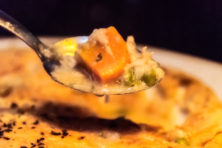The Last Pot
- Share
- Tweet
- Pin
- Share

Legacy Door County potter John Dietrich and wife, Diane McNeil, are closing their Ellison Bay gallery after 50 years in business.
After nearly 50 years in business, Ellison Bay Pottery is closing its gallery and putting the property up for sale. John Dietrich and his wife, Diane McNeil, said running the gallery has become too much, although they plan to continue making art. The six-acre property is across Garret Bay Road from The Clearing in Ellison Bay.
After six years assisting Abe Cohn at The Potter’s Wheel in Milwaukee and at its Door County site in Fish Creek near the Peninsula School of Art, Dietrich set up on his own. He bought the property that has some fruit trees and a barn, and then rebuilt and expanded the building to become a home, studio and gallery.
Business grew. He found, to his surprise, that he had acquired a following during his six years at The Potter’s Wheel, and Abe and Ginka Cohn sent people to Ellison Bay to find him.
Although both of his parents were accomplished painters, and his father, Thomas Dietrich, taught art at Lawrence University in Appleton, Dietrich decided that he preferred the feel of clay and the creation of pottery to working with painting on canvas. He chose to become a studio potter and has remained creatively restless throughout his career – experimenting, recording the results, and then experimenting and refining some more.
He recalled pushing on two sides of a piece, forming it into a sort of flat pot.

Inside Ellison Bay Pottery. Photo by Tom Groenfeldt. 
Inside Ellison Bay Pottery. Photo by Tom Groenfeldt.
“I came down the next day and it was partially dry,” he said. “I cleared off my wooden table, pushed on it, and it would make four sides automatically. I decided I was going to listen to the clay, the clay was going to make the shape. That’s how it’s asymmetric, because the clay said ‘I’m only going to go this far; you go further, Johnny, and it’s going to break.’”
He experimented with shapes.
“For practice, I would throw this shape and then cut it open to see what was happening, whether I was creating evenly thick walls,” he said.
All the while he was experimenting he was making notes, he said, as he pulled out recipe boxes filled with 3-by-5 index cards holding details of his processes – types of clay, firing records and recipes for glazes.
“I’ve got buckets of tests – you’ve got to be stubborn when you’re doing this,” he said. “Here’s my clay-body formula. This is my brain. I’d spend a whole week throwing shapes, trying to refine my skills. So I throw a mug shape. Cut it apart. Examine it. What did I need to do to make it better. My throwing improved dramatically. And, of course, the clay that I used I could rework. That’s one of the nice things about clay – you’re not doing anything bad to it. In fact, by working it you’re just making the clay better.”

Dietrich was focused on shapes in brown-and earth-tone stoneware during his early years as a potter, wrote his wife, Diane McNeil, in an explanatory note displayed at the gallery. While still at The Potter’s Wheel, Dietrich began adding lines of white porcelain to his pots, using a caulking gun to extrude a dynamic fine line, as a piece turned on the wheel. He also began adding color in slips – a mix of body clay and water the consistency of heavy cream which he could then brush onto a piece.
“A colored clay slip has an oxide mixed in, which eventually results in the colors you see on the pottery,” McNeil explained. “Oxides include cobalt, copper, iron, rutile and chrome. He also formulated a porcelain slip using the same technique with porcelain clay. Since porcelain clay dries at a different rate, he had to tweak the recipe so that the porcelain clay slip would dry at the same rate as his stoneware clay body. The porcelain slip was white and either opaque or translucent.”
Over the years he expanded his color pallet to include copper reds, purples, cobalt blue and eventually, the difficult green. Occasionally, he worked with porcelain rather than stoneware. His studio has two electric kilns, two gas kilns and a firing “pit” – built above-ground, for unglazed pieces that are purely decorative.
You can see some of the work for sale on the The Ellison Bay Pottery website ellisonbaypotterystudios.com, or call 920.740.5859 for more information or to make an appointment. Paintings by Dietrich’s parents are also for sale.


